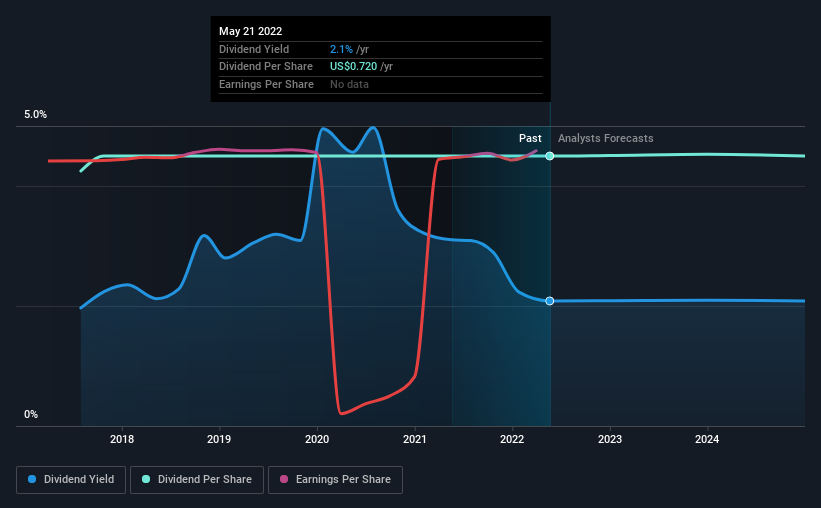Don't Race Out To Buy Baker Hughes Company (NASDAQ:BKR) Just Because It's Going Ex-Dividend
Baker Hughes Company (NASDAQ:BKR) stock is about to trade ex-dividend in four days. The ex-dividend date is one business day before a company's record date, which is the date on which the company determines which shareholders are entitled to receive a dividend. The ex-dividend date is of consequence because whenever a stock is bought or sold, the trade takes at least two business day to settle. Thus, you can purchase Baker Hughes' shares before the 27th of May in order to receive the dividend, which the company will pay on the 10th of June.
The company's next dividend payment will be US$0.18 per share. Last year, in total, the company distributed US$0.72 to shareholders. Calculating the last year's worth of payments shows that Baker Hughes has a trailing yield of 2.1% on the current share price of $34.55. We love seeing companies pay a dividend, but it's also important to be sure that laying the golden eggs isn't going to kill our golden goose! So we need to investigate whether Baker Hughes can afford its dividend, and if the dividend could grow.
Check out our latest analysis for Baker Hughes
Dividends are typically paid out of company income, so if a company pays out more than it earned, its dividend is usually at a higher risk of being cut. Baker Hughes paid out a disturbingly high 206% of its profit as dividends last year, which makes us concerned there's something we don't fully understand in the business. A useful secondary check can be to evaluate whether Baker Hughes generated enough free cash flow to afford its dividend. It paid out more than half (73%) of its free cash flow in the past year, which is within an average range for most companies.
It's disappointing to see that the dividend was not covered by profits, but cash is more important from a dividend sustainability perspective, and Baker Hughes fortunately did generate enough cash to fund its dividend. Still, if the company repeatedly paid a dividend greater than its profits, we'd be concerned. Extraordinarily few companies are capable of persistently paying a dividend that is greater than their profits.
Click here to see the company's payout ratio, plus analyst estimates of its future dividends.
Have Earnings And Dividends Been Growing?
When earnings decline, dividend companies become much harder to analyse and own safely. If business enters a downturn and the dividend is cut, the company could see its value fall precipitously. Readers will understand then, why we're concerned to see Baker Hughes's earnings per share have dropped 12% a year over the past five years. Ultimately, when earnings per share decline, the size of the pie from which dividends can be paid, shrinks.
Another key way to measure a company's dividend prospects is by measuring its historical rate of dividend growth. Baker Hughes has delivered 1.1% dividend growth per year on average over the past five years.
To Sum It Up
Has Baker Hughes got what it takes to maintain its dividend payments? Earnings per share have been shrinking in recent times. What's more, Baker Hughes is paying out a majority of its earnings and over half its free cash flow. It's hard to say if the business has the financial resources and time to turn things around without cutting the dividend. Bottom line: Baker Hughes has some unfortunate characteristics that we think could lead to sub-optimal outcomes for dividend investors.
So if you're still interested in Baker Hughes despite it's poor dividend qualities, you should be well informed on some of the risks facing this stock. To help with this, we've discovered 3 warning signs for Baker Hughes that you should be aware of before investing in their shares.
A common investing mistake is buying the first interesting stock you see. Here you can find a full list of high-yield dividend stocks.
Have feedback on this article? Concerned about the content? Get in touch with us directly. Alternatively, email editorial-team (at) simplywallst.com.
This article by Simply Wall St is general in nature. We provide commentary based on historical data and analyst forecasts only using an unbiased methodology and our articles are not intended to be financial advice. It does not constitute a recommendation to buy or sell any stock, and does not take account of your objectives, or your financial situation. We aim to bring you long-term focused analysis driven by fundamental data. Note that our analysis may not factor in the latest price-sensitive company announcements or qualitative material. Simply Wall St has no position in any stocks mentioned.

